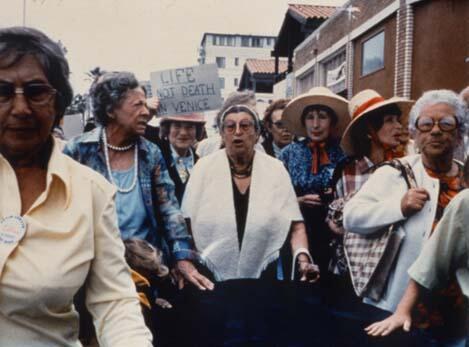Israel Levin Senior Center Members at the Life Not Death in Venice Protest
"One of the Center members was killed by a bicyclist who ran her down. 'I didn't see her;' he said, though she was directly in front of him. It was emblem-atic of all that had grown increasingly apparent to them over the years--the elderly were invisible. After the extensive coverage and attention pro-vided by the film, many members had become very sophisticated about manipulating their images and had grown sensitive to the power they could mobilize by reaching a broader, sympathetic outside public. An article in the newspaper titled "Death in Venice" decried the death. The elders took up the headline as a battle cry, made placards reading "Life Not Death in Venice;' and...they arranged a procession down the Boardwalk, accompanying a mock coffin (a refrigerator carton painted black, carried on a child's wagon), calling attention to their need for some safety zones where they could walk without being imperiled by bicycles and skateboards. Much media coverage assured them the attention they desired, and indeed, they were successful. A city ordinance prohibiting wheeled traffic in the area was enforced.
"The photograph of the parade became the logo for an exhibition of folk art and a celebration of Yiddishkeit that we mounted at the University of Southern California in 1980. The title was our own mnemonic device for remembering how important it was that these people were learning to empower themselves by appearing in public and com-manding attention."
Notes:
1. Barbara, Myerhoff, "Surviving Stories," Remembered Lives: the Work of Ritual, Storytelling, and Growing Older, ed. Marc Kaminsky (Ann Arbor: University of Michigan Press, 1992) 296.
Courtesy of the University Archives, University of Southern California East Library Building.



